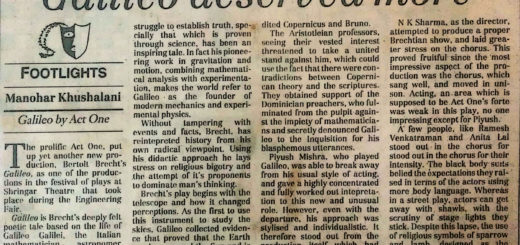Bharat Rang Mahotsav’16
Synopsis of six plays performed at Bharat Rang Mahotsav’16
The Mother of a Traitor
It was performed in Dollu Kunitha Form. It is one of the popular folk forms of Karnataka. It is generally played during festivals and fairs that take place in the name of respected regional Gods. It is a form of Drum dance where large drums are adorned with colored cloths and hung around the neck of men. The songs used in this dance usually have religious and battle fervour. The main emphasis is on quick and light movements of the feet and legs. It is a short story revolving around the concept of motherhood. The whole region is afraid of a traitor and his group for their menace due to which the life of people has got stuck with the malevolent blackness of their cry. The mother of traitor wanders around the walls of cit in quest of hers son’s existence and witness a woman kneeling down in front of her son’s corps. The woman says, “May he be accursed and the womb that bore him!” The mother meets her son and her son started expressing pride on his desks. Dealing with the conflict of love for her son on one side and country on the other, she finally kills her son, who is resting on her breasts.
The Transparent Trap
It was a non verbal play. The body language of the actors used was fantastic. Plastic is an important part of our lives. We, humans have used it in almost each and everything except the edible stuff. But we do used it in packing of edible stuff. We used plastic daily because of it’s extreme user friendly character. It is one of the prime reasons for global warming and ha skilled many aquatic, terrestrial and amphibian species. One of us invented it and now all of us use it extensively. A material which was invented for betterment and become the killer of humanity itself. This hazardous entity is destroying, choking and trapping all over. This play tries to search for solutions to find way out of plastic trap.
Tar aaya
It is based on introduction of tar roads to a small village in Mysore. The tar roads bring division of opinion between the youth and the more rigid elders of the village, seen as clash of modernity and traditional values. But interestingly, it is the village elders who are in favour of modernity while the young youth fights to keep it at bay. From a simple narrative, the story plunges into diverse issues of caste , religion and the role of women in rural society. The story refuses to submit to traditional defined roles and creates newer perspective of each issue. The nature of the story is inspirational even though it is grounded in reality. Though the ending is quite tragic as in the fight between urbanization and corruption, an innocent child is killed in the molten tar.
Dopehri
Dopehri is set in the streets of Lucknow where sits the haveli of an old lonely woman, Amma Bi. He brings to us her story, stringing us through the emotions and nuances of these characters and the milieu of an old Lucknow. It transports us through Amma Bi’s journey from loneliness to self discovery. It is based on the novella written by Pankaj Kapur and now rendered by him on stage, with the help of lights and music.
Nyayapriya
An underground progressive gathering arrangements to kill a British Collector in provincial India. Tej Pratap, a criminal living in Canada, comes and joins the gathering. Shekhar, prevalently called Mastana in the gathering, on seeing kids riding in the British authority’s carriage, does not toss the bomb as anticipated the learned day. There is warmed contention in the gathering as a result of this. Damyanti, a senior individual from the gathering, is infatuated with Shekhar. The gathering pioneer Baldev arrangements to toss the bomb two days after the fact. Shekhar is captured after the passing of the Collector. A watchfulness officer tries to purchase off Shekhar in the jail. English gatherer’s significant other and Pandit Trivedi visit Shekhar in the jail with the goal that he apologizes. Shekhar is hanged to death. Upon the arrival of the hanging Damyanti, profoundly lamented, chooses to toss the following bomb and endure a comparative destiny.
Land where the Life is Good
Land Where Life Is Good discusses the different personalities that are concealed in the covers of a solitary character called ‘Indian’. It tries to take a gander at the disarray that this activity of digestion for nationhood has made in the brains of the present era, particularly with regards to Nagaland. Does there exists a performance personality of a man or would we say we are today the result of numerous characters? What is bona fide – the old or the new? What are the bits of character that we clutched and why do we relinquish different bits? These are a portion of the inquiries that roused this generation. This is an endeavor to address these inquiries through the voyage of a youthful Naga kid – Tako, his unwavering pooch and his mystical performer companion Nogazenba. At no time do we attempt to answer the inquiries raised, on the grounds that for every person, the answers are distinctive.










